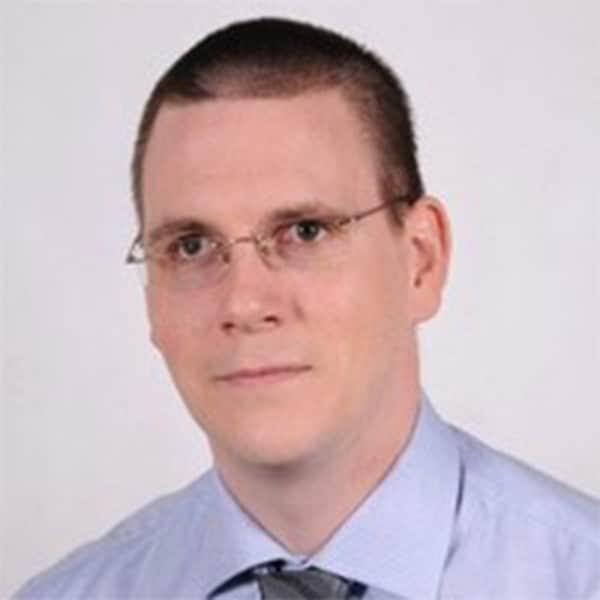
Mauro Gerber
Process Engineer & Statistical Expert, HUBER+SUHNER

Meg Hermes
User Reference Manager, JMP
Mauro Gerber is a process engineer and statistical expert working in data management, electrical testing and measurement for fiber optic cable manufacturer HUBER+SUHNER in Zurich. Prior to joining HUBER+SUHNER, Mauro spent 12 years working as an R&D process expert at German multinational glass manufacturer SCHOTT AG. In both his prior and current roles, Mauro has been an outspoken advocate of analytics enablement, piloting new training programs for engineers and procuring software to support the democratization of statistical thinking.
Meg: To start us off, I’m wondering if you could share your thoughts on the current state of statistical readiness in production industries.
Mauro: It seems a lot of companies are still struggling to grasp the idea of [domain experts] who also have a deep statistical understanding. I started my career as a process engineer and, over a couple of years, was doing more and more statistical analysis and modeling. Even 15 years later when I decided to join a different organization, I ended up in the same situation – hired as a process engineer instead of a data scientist.
Those of us [with both domain and statistical expertise] possess a broad knowledge of data engineering, analytics, process engineering, quality production; it's not just modeling! At the moment, I’m in a process engineering group at HUBER+SUHNER, but the more analytics I do, the more support I can offer to other engineers. Sometimes I see that they don’t fully understand what they are doing and get stuck in the process, which is why I set up a five-day course to really deepen their understanding of not just how to perform analytics, but also why to perform it.
Meg: What do you see as the main difference between traditional statistical training and statistical or analytical thinking?
Mauro: To me, it seems that classical teaching set a stage where every step you perform will work and lead to the desired result. It’s like learning how to drive a car. Sure, it is important to know how to steer, accelerate, brake and understand what all the buttons do, but also important is knowing how to avoid a bumpy road ahead or when to turn left or right – and you may get lost. This classical approach can lead to frustration or even lead you to quit statistics because it didn’t work as promised, even when you were following the chain of clicks as given in the examples.
Meg: So it's strict methods versus critical thinking.
Mauro: Yes. That’s the link that may prevent some people from being more successful in analytics or stop a constructive exchange or agreement. I stopped counting how many measurement system analyses (MSA) I had to redo because people were holding onto the notion that a sole index determines whether a system is capable, even when the process is very stable and thus measuring variation is very hard. The customer suggested we introduce “bad” parts into the mix. But then the process variation is not represented and the whole MSA becomes meaningless, because you can then freely choose what figures you will get by altering a piece.
I assume in that case someone taught them that if the index is below a certain value, the system is not capable, but not how that number comes to be and what it means.
Meg: Interesting. How do you explain the difference to those who are not as deeply immersed in analytics as you are? How do you build the business case to your management that they should support an evolution in thinking from Six Sigma to modern analytics?
Mauro: I find it personally difficult to communicate the benefits and future potential of statistics when I use it in my daily work and dive head-first into it when, on the other hand, it can look complicated and overwhelming when presented with formulas, graphics, numbers and endless ways to analyze data.
One thing I try is to write scripts that acquire data from databases or import from a file and reshape the table, so it becomes useful to the user. This helps avoid some hurdles in the first analytics steps by saving a lot of time; it can even trigger the curiosity to dig deeper.
Another approach is to start investigating the data together side by side, developing and showing the potential of analytics and – if possible – to include the other person’s knowledge and ideas. I can provide tools and a path to a solution, but the insight and feedback, if it’s useful, comes from the people who work with the process.
With this approach, I was able to convince our management to invest since more engineers wanted to do analytics themselves. Buying software is just one part of it.
Meg: And that’s where your training program comes in.
Mauro: Yes, although there are still barriers. When I first proposed a five-day course for engineers to learn JMP and statistical thinking, management hesitated. They said they couldn’t afford to have engineers off work for five days.
There's a saying: "We don't have time to sharpen our axes. We have to chop down trees." It was even suggested to me that we only send one person per department, who would then teach the others. It’s like I would only send one of my kids to school and then have them teach their siblings at home!
Meg: Quite conservative thinking, it seems.
Mauro: Not forcibly conservative, but that’s a normal situation in most companies, although MSA and SPC are necessary and requested by customers. These should be an integral part of the company in its effort to gain insights into processes that benefit stability and increase quality. But every organization needs people trained in statistical thinking to support that.
Meg: How have the engineers reacted to your course, both in regard to learning JMP and learning the statistical thinking skills that go with it?
Mauro: Very well, I would say. For example, I had a Six Sigma Black Belt who, at first, said, "Hey, I already had statistics training. I might pick up some bits or it might just be repetition, just to let you know." During the course, I could see that some coins dropped because he commented: “Aah, that’s why I should do this, now it makes more sense!” On another occasion, I had a site’s production, quality and engineering staff in the same training course and they had a discussion with a lot of a back-and-forth complaints and finger pointing. But during the course they started to understand what the other partner needed, why they requested certain figures, while also quantifying the impact of certain requests from the customer and ideas from engineering.
That’s why I love being an instructor.
Meg: Have you used any of the resources that are available through JMP – either personally or with the people who are taking your course?
Mauro: I had the pleasure of participating in the advanced training offered during JMP Discovery Summit about statistical modeling and finding important predictors. It was an enlightening coming-together of different minds with a knowledgeable trainer – and was supported with real-life examples that got me more into the modeling side of JMP.
What I recommend to new users of JMP is to work through the Welcome Kit, then take a day or two to train on their own. Next, they usually get a small face-to-face session with me to ask questions, and we may have a look at the personal examples they want to solve. The next step I recommend is taking the Statistical Thinking for Industrial Problem Solving (STIPS) course. It’s a rich course in statistics and a good way to get deeper into the possibilities of JMP and how to use it.
Meg: Do you feel like the younger generation of engineers – people who are coming up through the university system and taking jobs in industry – are more data savvy than when you were starting out?
Mauro: At the moment, I would say there hasn’t been much change. When I talk to younger engineers, they may have had a half semester here and there, but that's it, because coursework is more focused on mechanics. But I do think it’s evolving. Statistical education now is really coming up, and as more universities diversify their computer science curriculum – it’s getting more specialized.
Meg: What advice would you give to someone who's interested in pursuing an engineering track at university?
Mauro: I think statistics is becoming increasingly important in industry.
It’s not just that we replace paper with a digital format – that’s just the first step in an endurance race where you establish the base to empower statistical analytics. Even as companies add dedicated data scientists, it’s still important for engineers to understand the basics so that they can provide good data and good questions or ideas. It’s a team effort that brings together domain knowledge and statistical methods that improve and secure the success of a project.
As an example, I’d say it’s not necessary for engineers to know the exact formula that defines a normal distribution, but they should be able to understand that it represents the data and that we can predict or describe a process based on this link.
Meg: In an ideal world, if you were given a free pass to set up your own data analytics group, what would it look like?
Mauro: I would like to set up a central unit to tackle the more difficult statistical questions but also function as a hotline for coworkers who have questions about using JMP and writing scripts or need help with analytical questions.
Ideally, analytics enablement means that there is a group of people with diverse skills and knowledge. For example, maybe you have both a very good engineer with solid statistical understanding and a dedicated analyst who does reporting analytics, and they're connected through a subgroup or supervised by one very senior analyst who can help with more challenging problems. It's really that exchange that I would say can bring a lot of value, knowledge, time savings and so on.
Meg: Any final thoughts?
Mauro: I wish there were more understanding of the value of good analytics and making good decisions based on data, not just, "Yeah, we do digitalization." Or “We do big data.” Those are only catch phrases, and there needs to be people who understand what is necessary – and are assigned by management to enable the whole group to go in the direction of statistical thinking.
A smart factory doesn’t mean having only one or two smart people! It's the interaction between software, knowledge, people and processes - interdisciplinary teams are the key to success. It’s also a base for communication between engineering, quality and production. Achieving a true smart factory is a marathon, not a sprint.
